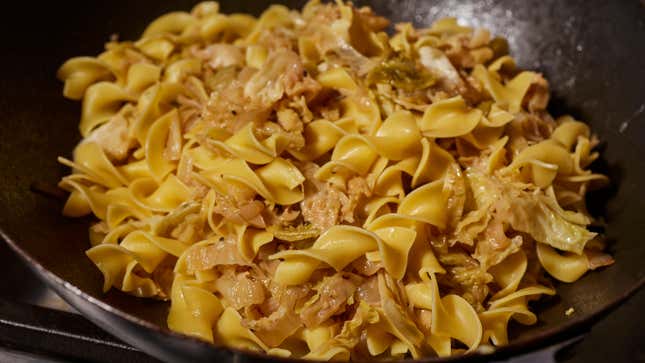
Pittsburghers like myself love their silly little language. Websites are dedicated to “Pittsburghese,” books are written on it, and scholars have studied it. I even own a pair of socks covered with some of the more popular terms (Yinz! Dahntahn! Nebby!). I can translate most of these colloquialisms, but one word that always tripped me up was “Hunky.” I mostly heard my dad use it in reference to food, and anytime I would ask him what that meant, he would simply repeat himself, “It’s just Hunky food.”
To finally answer the question for myself, I slid down a few Reddit rabbit holes. Now, I am happy to report on what you’ll be getting yourself into should a yinzer aggressively offer you a plate of Hunky food somewhere in Pittsburgh—probably at an Elks Lodge or in a church basement.
Where did the term “Hunky” come from?
From prejudices, of course. “Hunk” originally referred to an entire group of people who hailed from Central Europe: Hungarians, Czechs, Slovaks, Russians, Ukrainians, Slovenes, Serbs, and Croats. These were the folks who immigrated to the region and worked in its steel mills, and the locals would use the term as a slur.
Fast forward to modern Pittsburgh, where the steel is a bit more artisanal and the word has been mostly embraced by the steelworkers’ descendants (although it still touched a nerve as recently as 1990). Now, yinzers breezily use the word in reference to themselves or to describe stuff—particularly when it relates to food.
What dishes are considered Hunky food?
This is not a culture that is eating the rainbow: the cuisine comes in every shade of beige imaginable. Someone made a Pinterst board of Hunky food and it is one big sepia-toned scroll. It brings Bunnicula to mind, the rabbit that sucks the juice and vibrance out of vegetables. So if you’re someone who eats with your eyes first, maybe go in with a blindfold to this one.
Despite its lack of visual appeal, the food is big on satiation. These meals had to power men through their shifts at the mill, propel women through mothering enormous families, and give children the energy to walk uphill both ways to school. Did Joe Magarac, the folk hero steelworker who was Pittsburgh’s answer to Paul Bunyan, pack pierogi for lunch before bending steel with his bare hands? Probably!
The core components are potatoes, cabbage, pork, and grains (in bread or noodle form). The resulting dishes include:
- Haluski: egg noodles and fried cabbage
- Pierogi: always best when stuffed with potatoes and cheese, sometimes found running through PNC Park
- Kielbasa: smoked sausage
- Sauerkraut: actually a perfect food that belongs on everything
- Bobalki: bread rolls that can either be sweet with poppyseeds and honey or savory with sauerkraut
- Pampushka: also bread rolls
- Potato pancakes: in my experience, these are less like shredded potato latkes and more like leftover mashed potatoes mixed with a little flour and tossed into a hot, oiled pan
If you find yourself in Southwestern Pennsylvania, get a local to point you toward some of the above dishes. If that yinzer starts rambling about spots in the “Mon Valley” or gives you directions that are mostly based on landmarks that no longer exist, you’re about to find yourself in Hunky heaven.